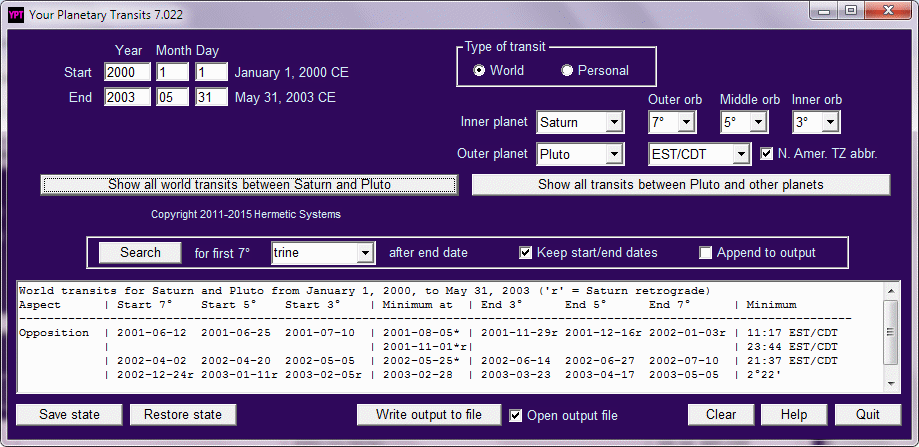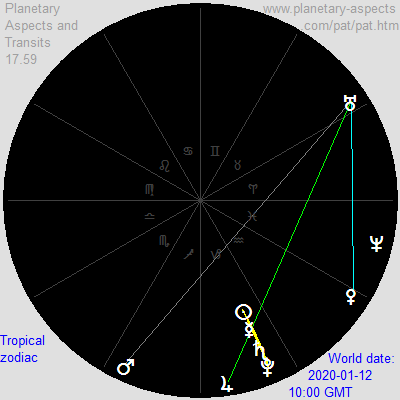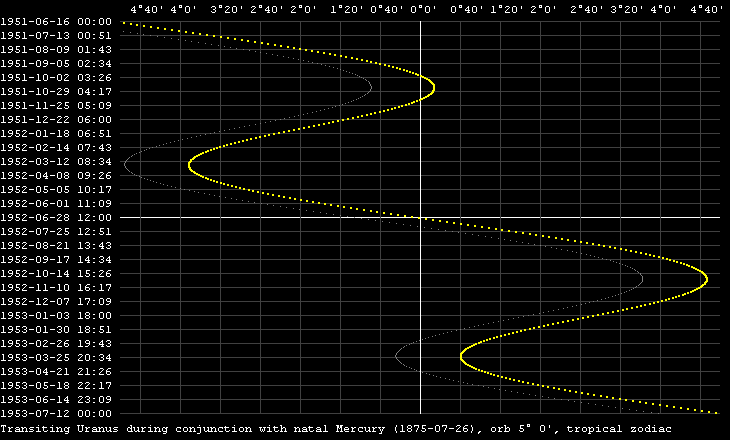Your Planetary Transits
Transit Search |
| Back to Contents |
For example, on September 11, 2001, Saturn was within a 3° opposition to Pluto.

From this transit table we see that Saturn began a 3° opposition to Pluto on July 10, 2001, the opposition became exact on August 5, and again on November 1, and this 3° opposition ended on November 29, with another 3° opposition in 2002 and another in 2003. (The planetary configuration on the morning of September 11, 2001, is shown here. A grand trine, a kite, a T-square and a trapezium were all present.)
If you now wish to know the date of the next conjunction after this opposition then set the drop-down aspect list to 'conjunction' and check the checkboxes as below:
Click on 'Search' to get this result:

So the next exact conjunction of Saturn and Pluto is January 12, 2020. Actually this conjunction is part of a 4-stellium with the Sun, Mercury, Saturn and Pluto all pairwise in close conjunction, as shown in this image from the Planetary Aspects and Transits software:

Now an example involving personal transits.
Suppose you are interested in occurrences of Uranus conjunct with C.G.Jung's natal Mercury from 1951 onward. Enter Jung's birth date and time (July 26, 1875, 19:30 GMT+1), and set the end date to January 1, 1951. Be sure to uncheck the 'Keep start/end dates' checkbox. Set the outer orb to 5° (ignore any error message regarding the other orbs).

Then click on 'Search'. The result is:

which shows that Uranus was exactly conjunct with Jung's natal Mercury on September 27, 1951; November 13, 1951 (when Uranus was retrograde); and June 28, 1952.
The start and end dates have been automatically set to those for this 5°-conjunction. Clicking on the 'Search' button again displays the next 5°-conjunction:

So the 5°-conjunction of Uranus and natal Mercury in 1951-1952 was the last one to occur in Jung's lifetime (he died in 1961).
Note that the values specified for the outer, middle and inner orbs don't affect the results of a transit search.
The results are different when the sidereal zodiac is used, namely:

which shows that (according to the sidereal zodiac) Uranus was exactly conjunct with Jung's natal Mercury on July 16, 1952; February 20, 1953 (when Uranus was retrograde); and April 22, 1953.
Although personal transit dates differ according to which zodiac is used (as explained here), in this case the differences are unusually large (exact conjunctions in 1951-52 according to the tropical zodiac vs. exact conjunctions in 1952-53 according to the sidereal zodiac). This case is best understood by examining the following transit graphic (produced by the Planetary Aspects and Transits software):

The yellow line is the transit according to the tropical zodiac and the gray line is the transit according to the sidereal zodiac. It can be seen that the dates of exact conjunctions are significantly different even though on any particular date the difference between the difference from exact conjunction in the two zodiacs is never more than about 1°.
Now another example involving personal transits.
Suppose you were born on December 21, 1947, at 07:30 GMT, and you want to know when your Uranus return will be. Set the birth date/time to this, select the type of transit as 'personal', and select Uranus for both transiting planet and natal planet. Uranus takes about 84 years to return to its position in your natal chart, so set the end date to January 1, 2000, then tell the program to search for the first 5° conjunction after the end date. The output is:

This 5° transit does not include an exact conjunction (though it comes close to one, at 1°3'), so does not show your Uranus return. To get the date of that set the end date to the end date of this transit, February 9, 2031, then click on 'Search' again. The output is:

This shows your Uranus return, with exact conjunctions on June 30, 2031; January 18, 2032; and April 11, 2032.
By a similar process you can find the dates of your Jupiter and Saturn returns. Also you can find the dates when any of the outer planets first forms a square or an opposition with its corresponding natal planet. For example, using the birth date/time above, Uranus forms an exact opposition with the natal Uranus three times in 1987, on January 7, July 6 and October 26.
| Your Planetary Transits | Home Page |